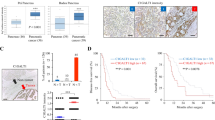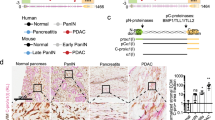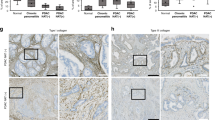Abstract
Pancreatic cancer is a devastating disease with poor prognosis. Production of large quantities of extracellular matrix and early metastasis are characteristics of this disease. One important step in the development of various cancers is the loss of E-cadherin gene expression or inactivation of E-cadherin mediated cell–cell adhesion. It has been shown that collagen type I promotes downregulation of E-cadherin expression, which correlates with enhanced cell migration and invasiveness. In this context, we elucidated the role of Smad-interacting protein 1 (SIP1), which has been discussed as a negative regulator of E-cadherin gene expression. We demonstrate that SIP1 upregulation shows an inverse relationship with E-cadherin in advanced pancreatic tumour stages. In Panc-1 cells, SIP1 expression can be induced by exposure to collagen type I in a src-dependent manner. In addition, overexpression of SIP1 reduces E-cadherin mRNA and protein levels. Taken together, these results suggest that SIP1 is involved in the progression of pancreatic cancer and plays a role in mediating signal transduction from collagen type I to downregulate E-cadherin expression.
This is a preview of subscription content, access via your institution
Access options
Subscribe to this journal
Receive 50 print issues and online access
$259.00 per year
only $5.18 per issue
Buy this article
- Purchase on Springer Link
- Instant access to full article PDF
Prices may be subject to local taxes which are calculated during checkout




Similar content being viewed by others
References
Avizienyte E, Frame MC . (2005). Src and FAK signalling controls adhesion fate and the epithelial-to-mesenchymal transition. Curr Opin Cell Biol 17: 542–547.
Batlle E, Sancho E, Franci C, Dominguez D, Monfar M, Baulida J et al. (2000). The transcription factor snail is a repressor of E-cadherin gene expression in epithelial tumour cells. Nat Cell Biol 2: 84–89.
Berx G, Becker KF, Höfler H, van Roy F . (1998). Mutations of the human E-cadherin (CDH1) gene. Hum Mutat 12: 226–237.
Birchmeier W, Behrens J . (1994). Cadherin expression in carcinomas: role in the formation of cell junctions and the prevention of invasiveness. Biochim Biophys Acta 1198: 11–26.
Blake RA, Broome MA, Liu X, Wu J, Gishizky M, Sun L et al. (2000). SU6656, a selective src family kinase inhibitor, used to probe growth factor signaling. Mol Cell Biol 20: 9018–9027.
Cano A, Perez-Moreno M, Rodrigo I, Locascio A, Blanco MJ, del Barrio MG et al. (2000). The transcription factor snail controls epithelial–mesenchymal transitions by repressing E-cadherin expression. Nat Cell Biol 2: 76–83.
Comijn J, Berx G, Vermassen P, Verschueren K, van Grunsven L, Bruyneel E et al. (2001). The two-handed E box binding zinc finger protein SIP1 downregulates E-cadherin and induces invasion. Mol Cell 7: 1267–1278.
D’Souza-Schorey C . (2005). Disassembling adherens junctions: breaking up is hard to do. Trends Cell Biol 15: 19–26.
Erickson AC, Barcellos-Hoff MH . (2003). The not-so innocent bystander: the microenvironment as a therapeutic target in cancer. Expert Opin Ther Targets 7: 71–88.
Frixen UH, Behrens J, Sachs M, Eberle G, Voss B, Warda A et al. (1991). E-cadherin-mediated cell–cell adhesion prevents invasiveness of human carcinoma cells. J Cell Biol 113: 173–185.
Hajra KM, Chen DYS, Fearon ER . (2002). The SLUG zinc-finger protein represses E-cadherin in breast cancer. Cancer Res 62: 1613–1618.
Heidenblut AM, Lüttges J, Buchholz M, Heinitz C, Emmersen J, Nielsen KL et al. (2004). aRNA-longSAGE: a new approach to generate SAGE libraries from microdissected cells. Nucleic Acids Res 32: e131.
Hennig G, Behrens J, Truss M, Frisch S, Reichmann E, Birchmeier W . (1995). Progression of carcinoma cells is associated with alterations in chromatin structure and factor binding at the E-cadherin promoter in vivo. Oncogene 11: 475–484.
Long J, Zuo D, Park M . (2005). Pc2-mediated sumoylation of Smad-interacting protein 1 attenuates transcriptional repression of E-cadherin. J Biol Chem 280: 35477–35489.
Maeda G, Chiba T, Okazaki M, Satoh T, Taya Y, Aoba T et al. (2005). Expression of SIP1 in oral squamous cell carcinomas: implications for E-cadherin expression and tumor progression. Int J Oncol 27: 1535–1541.
Menke A, Philippi C, Vogelmann R, Seidel B, Lutz MP, Adler G et al. (2001). Down-regulation of E-cadherin gene expression by collagen type I and type III in pancreatic cancer cell lines. Cancer Res 61: 3508–3517.
Mikkers H, Allen J, Knipscheer P, Romeijn L, Hart A, Vink E et al. (2002). High-throughput retroviral tagging to identify components of specific signaling pathways in cancer. Nat Genet 32: 153–159.
Miyoshi A, Kitajima Y, Sumi K, Sato K, Hagiwara A, Koga Y et al. (2004). Snail accelerates cancer invasion by upregulating MMP expression and is associated with poor prognosis of hepatocellular carcinoma. Br J Cancer 90: 1265–1273.
Mollenhauer J, Roether I, Kern HF . (1987). Distribution of extracellular matrix proteins in pancreatic ductal adenocarcinoma and its influence on tumor cell proliferation in vitro. Pancreas 2: 14–24.
Pignatelli M, Ansari TW, Gunter P, Liu D, Hirano S, Takeichi M et al. (1994). Loss of membranous E-cadherin expression in pancreatic cancer: correlation with lymph node metastasis, high grade, and advanced stage. J Pathol 174: 243–248.
Postigo AA, Depp JL, Taylor JJ, Kroll KL . (2003). Regulation of Smad signaling through a differential recruitment of coactivators and corepressors by ZEB proteins. EMBO J 22: 2453–2462.
Remacle JE, Kraft H, Lerchner W, Wuytens G, Colart C, Verschueren K et al. (1999). New mode of DNA binding of multi-zinc finger transcription factors: deltaEF1 family members bind with two hands to two target sites. EMBO J 18: 5073–5084.
Rosivatz E, Becker I, Specht K, Fricke E, Luber B, Busch R et al. (2002). Differential expression of the epithelial–mesenchymal transition regulators snail, SIP1, and twist in gastric cancer. Am J Pathol 161: 1881–1891.
Seidel B, Braeg S, Adler G, Wedlich D, Menke A . (2004). E- and N-cadherin differ with respect to their associated p120ctn isoforms and their ability to suppress invasive growth in pancreatic cancer cells. Oncogene 23: 5532–5542.
Van de Putte T, Maruhashi M, Francis A, Nelles L, Kondoh H, Huylebroeck D et al. (2003). Mice lacking ZFHX1B, the gene that codes for Smad-interacting protein-1, reveal a role for multiple neural crest cell defects in the etiology of Hirschsprung disease–mental retardation syndrome. Am J Hum Genet 72: 465–470.
Van Grunsven LA, Michiels C, Van de Putte T, Nelles L, Wuytens G, Verschueren K et al. (2003). Interaction between Smad-interacting protein-1 and the corepressor C-terminal binding protein is dispensable for transcriptional repression of E-cadherin. J Biol Chem 278: 26135–26145.
Verschueren K, Remacle JE, Collart C, Kraft H, Baker BS, Tylzanowski P et al. (1999). SIP1, a novel zinc finger/homeodomain repressor, interacts with Smad proteins and binds to 5′-CACCT sequences in candidate target genes. J Biol Chem 274: 20489–20498.
Vleminckx K, Vakaet Jr L, Mareel M, Fiers W, van Roy F . (1991). Genetic manipulation of E-cadherin expression by epithelial tumor cells reveals an invasion suppressor role. Cell 66: 107–119.
Yang J, Mani SA, Donaher JL, Ramaswamy S, Itzykson RA, Come C et al. (2004). Twist, a master regulator of morphogenesis, plays an essential role in tumor metastasis. Cell 117: 927–939.
Yoshiura K, Kanai Y, Ochiai A, Shimoyama Y, Sugimura T, Hirohashi S . (1995). Silencing of the E-cadherin invasion-suppressor gene by CpG methylation in human carcinomas. Proc Natl Acad Sci USA 92: 7416–7419.
Acknowledgements
We thank Dr Walter Birchmeier (MDC, Berlin, Germany) for the gift of the pCat-Ecad178 plasmid. This work was funded by the DFG, SFB 518.
Author information
Authors and Affiliations
Corresponding author
Additional information
Supplementary Information accompanies the paper on the Oncogene website (http://www.nature.com/onc).
Supplementary information
Rights and permissions
About this article
Cite this article
Imamichi, Y., König, A., Gress, T. et al. Collagen type I-induced Smad-interacting protein 1 expression downregulates E-cadherin in pancreatic cancer. Oncogene 26, 2381–2385 (2007). https://doi.org/10.1038/sj.onc.1210012
Received:
Revised:
Accepted:
Published:
Issue Date:
DOI: https://doi.org/10.1038/sj.onc.1210012
Keywords
This article is cited by
-
Molecular and metabolic regulation of immunosuppression in metastatic pancreatic ductal adenocarcinoma
Molecular Cancer (2023)
-
Regulation of epithelial-mesenchymal transition and organoid morphogenesis by a novel TGFβ-TCF7L2 isoform-specific signaling pathway
Cell Death & Disease (2020)
-
The role of collagen in cancer: from bench to bedside
Journal of Translational Medicine (2019)
-
Smad interacting protein 1 influences transforming growth factor-β1/Smad signaling in extracellular matrix protein production and hypertrophic scar formation
Journal of Molecular Histology (2019)
-
The hepatic pre-metastatic niche in pancreatic ductal adenocarcinoma
Molecular Cancer (2018)



